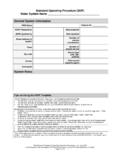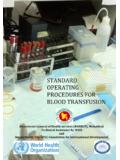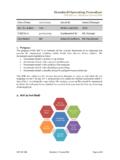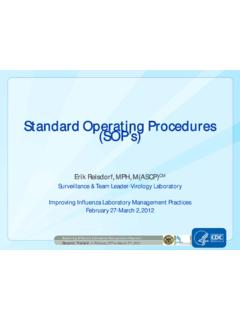Transcription of Appendix How to Write a Standard Operating …
1 1On-Farm Decision Tree Project: Appendix How to Wrtie and SOP v1 8/22/14 Bihn, Schermann, Wszelaki, Wall, and Amundson, 2014 Standard Operating Procedure (SOP) is a document that provides step-by-step instructions on how to complete a specific task properly. An SOP may have several distinct parts to help organize and outline all parts of the process. These parts may include a title, purpose (what), scope (who), responsibility (why), materials, and procedure (how). See the example SOP below for more detail on writing each one of these sections. Remember, this is your farm, your food safety plan, and your SOP.
2 Use whatever termi-nology and layout work for you, your workers, and your farm. The template is provided to help you get started and think through the task in a logical order, but feel free to modify it so it works on your you begin to develop an SOP, it is helpful to watch someone actually do the task and Write down every-thing they do. If a particular step has multiple actions, you may want to break out longer steps into sub-steps to make sure your instructions are clear to the person following the SOP. Once you have developed your first draft of instructions, ask other workers or someone who is not familiar with the task to review your SOP.
3 Your SOP should be clear enough that any person could pick up the instructions and complete the task without assistance. For example, if there was a family emergency and the farm must be taken care of by someone else, SOPs are critical in making sure all the farm tasks are completed properly while you are away. After initial review and revision of your SOP, it is important to give it a trial run. Ask a worker, spouse, friend, or family member to follow the SOP while you watch. Take note of any clarification that could be provided in your instructions to make the process clearer to the user.
4 Do they waiver on a specific step? Do they know where to find the tools, chemicals, and other materials needed to complete the task? Have they used the right equipment? If you find that the person completing the SOP does not follow the directions as expected, ask for clarification and revise your instructions. Once your SOP is complete, it should not disappear into a folder, never to be seen again. All workers who may be doing that particular task must be trained to follow the SOP. It is best to post the SOP near where the task is being completed. For example, you can use a plastic sheet cover and a bit of duct tape to post the SOP inside your packinghouse or barn where the task is normally performed.
5 Encourage your workers to notify you if a particular SOP needs to be edited because of a change in the process, chemical suppli-er ( , new sanitizer being used), new equipment, or if it is unclear to them. SOPs are more than just a piece of paper in your Farm Food Safety Plan. In the busy season, SOPs can save you time by avoiding having to repeat the instruc-tions to new workers or seasonal volunteers. Having written instructions for how to complete specific tasks also makes sure that your Farm Food Safety Plan is being implemented properly. In most Decision Tree portfolios, you will find sam-ple SOPs for food safety practices.
6 Another sample SOP is provided below. Again, this is YOUR farm and YOUR farm food safety plan, so edit the SOPs to fit your farm and reflect what you are doing! Appendix How to Write a Standard Operating Procedure (SOP)On-Farm Decision Tree Project: Appendix How to Wrtie and SOP v1 8/22/14 Bihn, Schermann, Wszelaki, Wall, and Amundson, 2014 : Washing and Sanitizing 5-gallon Red Plastic Harvest TotesDate: July 5, Purpose This section explains what task will be outlined and completed after following the instructions. This SOP describes how to wash and sanitize the red plastic 5 gallon harvest Scope The scope describes who is included and what areas of the farm may be covered under this SOP.
7 These instructions apply to the harvest crew and CSA volunteers using the red plastic 5 gallon harvest totes in the field and packinghouse. Responsibility This section outlines WHY the task needs to be done. Adults learn best when they are provided a justification of why the task is important and who is responsible. Totes must be properly cleaned and sanitized to prevent contamination of produce that is harvested and car-ried in the totes. MaterialsProvide a list of all the materials you need to accomplish the task and where to find them in this section. n Unscented dish soap ( , Dawn )n Clorox (approved for use on food contact surfaces), NaOCln Measuring tablespoonn Plastic measuring cup (2 cup volume)n 2 clean plastic buckets for mixing soap and sanitizer solutionsn Clean plastic brushes for scrubbing totesn Sprayer nozzle for hosen Potable water sourceAll materials are stored in the packinghouse side storage room on the second metal rack.
8 Let Joe (farm owner) know if any of the supplies are running low or need to be replaced. On-Farm Decision Tree Project: Appendix How to Wrtie and SOP v1 8/22/14 Bihn, Schermann, Wszelaki, Wall, and Amundson, 2014 ProcedureThe procedure should include step-by-step instructions on how to complete the task. 1. Measure 2 teaspoons dish soap and mix into clean plastic bucket filled to top line with 2 gallons of water from the packinghouse hose. 2. Measure 1 tablespoon Clorox with the measuring spoon and mix into a clean plastic bucket filled to top line with 2 gallons of water from the packinghouse hose.
9 This will make ~100ppm chlorine solution for sanitizing. 3. Spray out one dirty red plastic tote with clean water using the packinghouse house to remove any dirt or leaves from harvesting, just outside the packinghouse entrance on the concrete washing pad. 4. Fill measuring cup to top with soapy water (2 C.) and pour it into one dirty red plastic tote. Use clean scrub brushes to scrub all surfaces to remove dirt. Flip tote over and pour out soapy water into the packinghouse floor drain. 5. Rinse the inside of the tote with clean water from the hose to remove residual suds. 6. Fill one measuring cup to the top (2 C.)
10 With the Clorox solution you prepared. Pour the sanitiz-ing solution into the red tote. Use a clean brush designated for use with the sanitizer to scrub the inside surface and swish around the sanitizer for 1 minute, so that the entire bucket has been sani-tized. Flip tote over and pour out sanitizer solution into the packinghouse floor drain or designated area where water can be disposed of properly. 7. While holding the tote upside-down, rinse the inside with potable water from the packinghouse hose and shake out excess water. 8. Place cleaned and sanitized totes on the designated red hooks on the East side of the packing-house to drip dry.










